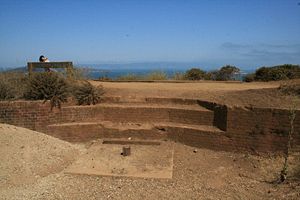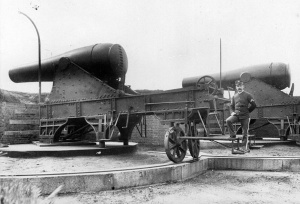1870s System
|
1870s System (1870-1876) - Began with the end of the U.S. Civil War in 1865 and extended to the cutoff of Congressional funding for Seacoast fortifications in 1876. Followed by the Endicott Period. Little or no Congressional funding for seacoast defenses was provided in the years between the periods (1876-1890). Technological changes during the U.S. Civil War clearly obsoleted the Third System coast and harbor defenses. The masonry Third System fortifications could not stand up to large caliber rifled shipboard guns and ironclad vessels. The huge profile of these forts made them attractive targets and they could be besieged and reduced to rubble in a short span of time with little cost to the attackers. Temporary fortifications surrounding major cities during the war had been constructed of earth and log works providing a relatively cheap and easily constructed defense. Earth and especially sand proved to have much more stopping power than masonry walls and any damage done could be repaired overnight. The Third System forts were expensive to build and almost impossible to repair under battle conditions. After the war these lessons were applied to coastal and harbor defenses so that instead of constructing large masonry forts, dispersed gun batteries with protective earthworks backed with stone or concrete instead of logs were built. The old forts were retained but only to provide strong points and suport for outlying batteries with occasional guns mounted on the barbette tier. In places where there was no Third System fort the batteries provided their own defense. The transition from masonry coastal forts to earthworks coastal forts and batteries began during the U.S. Civil War and can be seen in new fortifications built on the west coast. Fort Stevens was begun early in the war but not finished until April 1865. It was built as an earthworks with a few masonry elements but mostly with log, plank and earth elements. Unmaintained after the war the gun platforms soon deteriorated and the fort was placed in caretaker status. It was not until the Endicott Period refortification brought eight large caliber concrete gun batteries that Fort Stevens was resurrected. The Old Fort Stevens became the site of one of these batteries. Even later construction at Battery Cavallo and Battery Ridge reflected the 1870s System concept of detached earthworks batteries. These batteries contained internal masonry elements (communications tunnels, magazines and gun mounts) but were surrounded with earthworks and covered where possible with earth and/or sand to create bombproof structures. This combination proved very successful and was carried forward through World War II with reinforced concrete batteries fronted and covered with earth and sand. Some of the early 1870s structures still survive and examples can be seen at Battery Cavallo and Battery Ridge on the north side of the Golden Gate at Fort Baker. The end came for the 1870 System improvement in 1876 when a cost conscious Congress cut off construction funding for harbor defenses. Funding would not resume until technology again forced the massive Endicott Period construction program. See Also: Sources:
Links: | ||||


